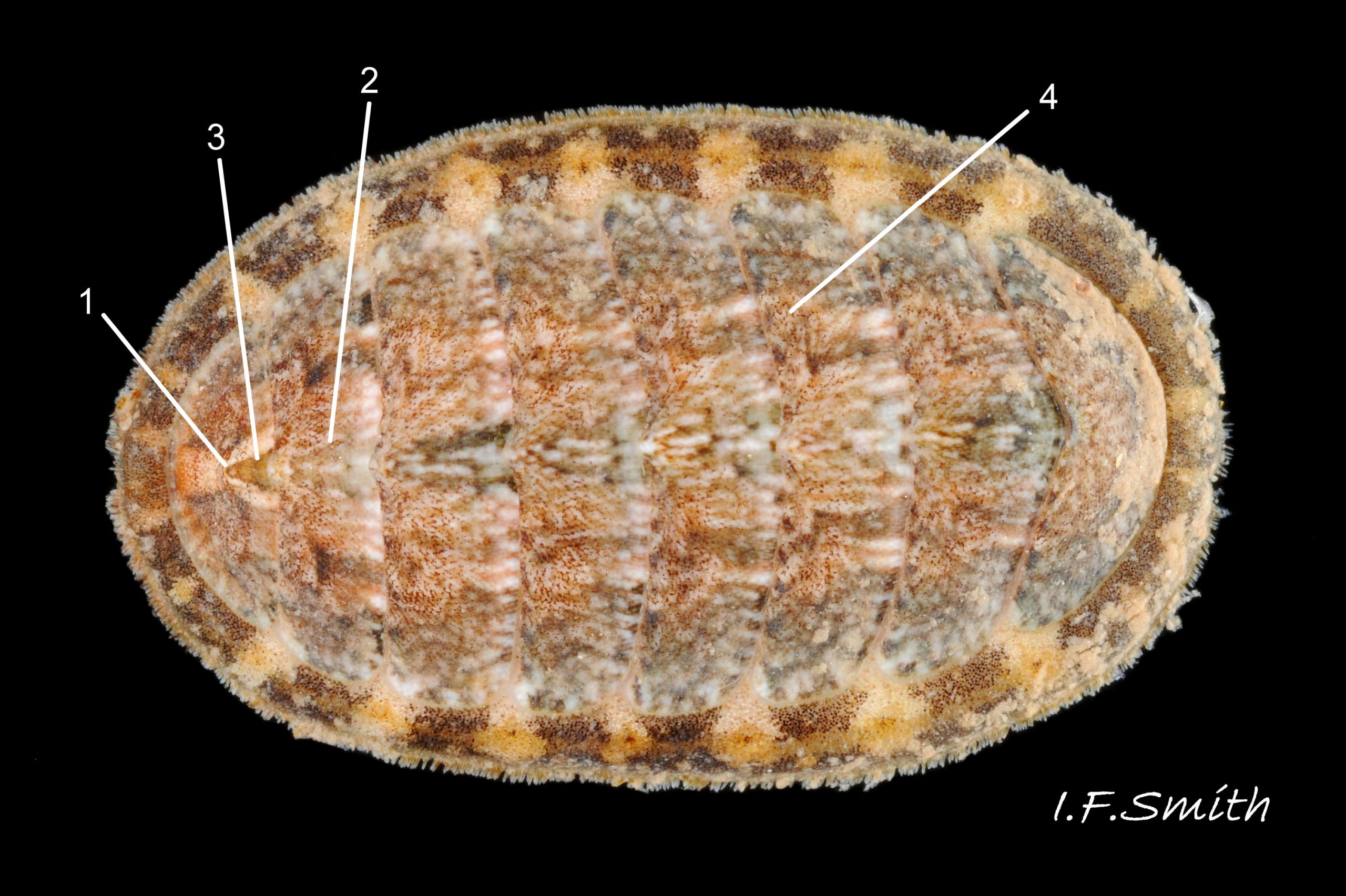Length 13.5mm. Dorso-ventrally flattened, bilaterally symmetrical. Outline elliptical; width about 60 to 70% of length. About 25% of animal width occupied by narrow girdle.
1: almost central mucro on semicircular tail valve (viii) resembles slight apex/beak of other valves.
2: triangular jugal area on intermediate valve; discernible by different shade of brown with longitudinal streaks of white on valves ii-vii. (See image 10 10 Lepidochitona cinerea. for more clearly defined jugal area.)
3: antemucronal area resembles jugal area of intermediate valves.
4: valve granules unobtrusive on intensely patterned valves.
Menai Strait, Wales. February 2014.
KEY ID FEATURES and similar species below.
Lepidochitona cinerea (Linnaeus, 1767).
a) Only chiton species likely to be found higher than MLW on British shores. Has diverse colour forms , some similar to other spp. such asTonicella rubra or Leptochiton cancellatus.
b)Dorsal surface of valves has numerous rounded, sometimes slightly elongated, granules visible at X5 magnification 09 Lepidochitona cinerea .
c) Apophyses on intermediate valves wide, rounded, slightly-triangular.
d)Dorsal surface of girdle has densely packed rounded granules 09 Lepidochitona cinerea .
e)Girdle usually has alternating dark and light transverse lozenge-like bands of approximately equal size. Dark bands usually have narrow waist, and light bands usually have a bulging waist 17 Lepidochitona cinerea (or vice versa 08 Lepidochitona cinerea ). A thin paler longitudinal line often runs across the waist of dark bands. Usually a dark central spot on pale bands. Markings can be partially developed, very indistinct, or absent flic.kr/p/nNRJMS (P.Lightfoot2) on pale specimens.
f) Intermediate valves moderately highly arched with keel and posterior beak; valve 5 height about 32% of width; distinctly higher than that of Tonicella rubra 05 Lepidochitona cinerea COMPARISON Boreochiton ruber and Tonicella marmorea. .
g)Usually 16 to 19 ctenidia each side, arrangement holobranch 15 Lepidochitona cinerea .
h) All round British isles on rocky shores.
Similar species
Leptochiton cancellatus 26 Lepidochitona cinerea
a) At LWS and sublittorally.
b) Dorsal surface of valves has many closely packed granules in almost-straight chain-like rows running antero-posteriorly and, usually, a few strong growth lines.
c) Narrow triangular apophyses on intermediate valves.
d) Dorsal surface of girdle has densely-packed squarish scales with curled up tips.
e) No distinctive pattern on girdle.
f) Intermediate valves highly and smoothly arched with neither keel nor posterior beak 25 Lepidochitona cinerea COMPARISON & 26 Lepidochitona cinerea .
g) About five ctenidia on each side near posterior; merobranch arrangement.
h) Widespread around Britain, scarce in southern North Sea.
Tonicella marmorea O. Fabricius, 1780.
a) At LWS and sublittorally.
b) Dorsal surface of valves has growth lines and, at X5 magnification, numerous distinct small granules 17Tr 17 Boreochiton ruber COMPARISON Tonicella marmorea . (Granules, not as large as on L. cinerea, may not be discernible in underwater images or on specimens before deposits and properiostracum removed.)
c) Apophyses on intermediate valves short (i.e. anterior-posterior), wide and gently curved 17Tr 17 Boreochiton ruber COMPARISON Tonicella marmorea . (Note, apophyses in 4 in Kaas & Belle appear to be worn/damaged to stronger curve. Fig.19 in Jones & Baxter shows un-damaged apophyses more accurately.)
d) Dorsal surface of girdle has sparse minute granules(c.27μm long) that do not touch each other. (Usually escape notice in photographs.)
e) Girdle variably coloured and patterned; deep purple-red to green and may have orange bands; some may resemble T. rubra.
f) Dorsal surface of valves ii to vii flat or weakly convex upper slope, separated by hip from slightly concave lower slope 05 Lepidochitona cinerea COMPARISON Boreochiton ruber and Tonicella marmorea. . Low keeled arch, similar height/width ratio to T. rubra.
g) 17 to 26 ctenidia each side, arrangement merobranch.
h)Not found south of North Wales or Northumberland. (Many erroneous records on mapping schemes as easily confused with T. rubra.)
Tonicella rubra (Linnaeus, 1767).
a) At LWS and sublittorally.
b)Dorsal surface of valves smooth apart from growth lines. (Faint stippling may be visible at X30 magnification.) 17Tr 17 Boreochiton ruber COMPARISON Tonicella marmorea .
c)Apophyses, especially on valves iii –v, are markedly prominent and rounded, almost semicircular 17Tr 17 Boreochiton ruber COMPARISON Tonicella marmorea .
d) Dorsal surface of girdle has densely-packed, elongate (50 to 60μm), club-shaped granules with packed touching heads giving a mealy appearance. 14Tr 14 Boreochiton ruber .
e)Girdle usually has alternating dark and pale transverse bands. Pale bands, often fragmentary, usually thinner than dark bands, and roughly in line with shell-sutures 2Tr 02 Boreochiton ruber .
f)Dorsal surface of valves ii – vii makes a keeled arch with smoothly-curved or flattish sides when viewed in profile from posterior 05 Lepidochitona cinerea COMPARISON Boreochiton ruber and Tonicella marmorea. . Keeled arch distinctly lower than that of Lepidochitona cinerea, but only slightly higher than on T. marmorea.
g) About 12 ctenidia each side (range 10-15), arrangement merobranch 12 Tr 12 Boreochiton ruber .
h) Widespread around Britain except southern North Sea.

